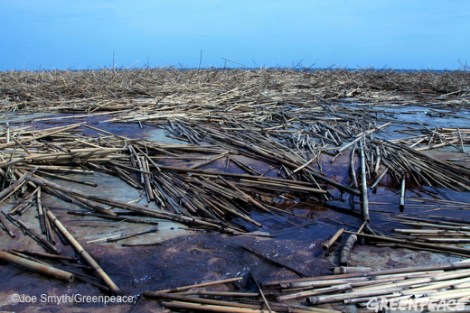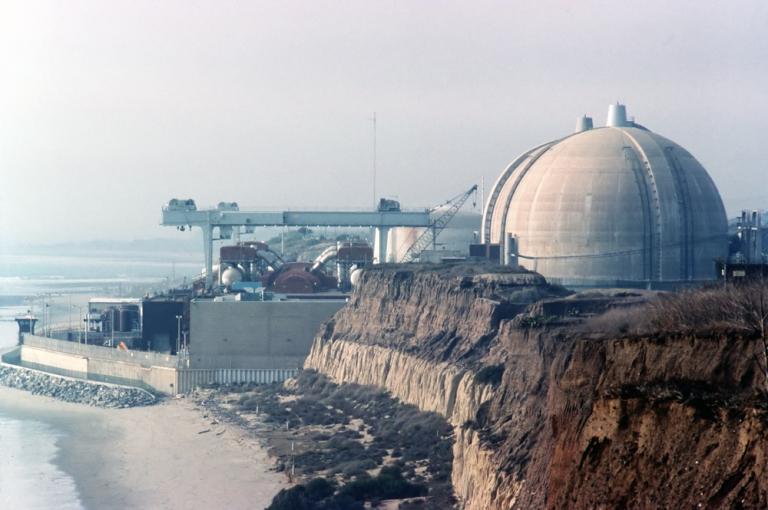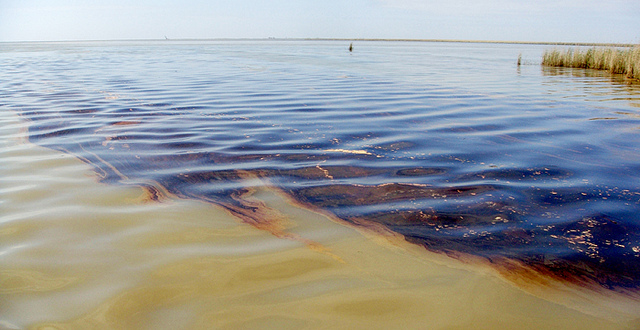
Oil and reeds washed up by Hurricane Isaac on West Ship Island, Miss., Sept. 4, 2012.
When BP’s Deepwater Horizon oil rig exploded in 2010, it hemorrhaged roughly 210 million gallons of crude into the Gulf of Mexico. We know now, thanks to recent court hearings and settlements, that all this happened because oil-company managers were cutting corners on safety, and the federal government’s monitoring system for offshore drilling was broken.
We also know that it wasn’t the first time oil companies had spilled in the Gulf. What we don’t know — and probably never will — is how much oil has been spilled. Even now, three years after the Deepwater disaster, many spills go unreported. And now we’re learning that even when companies report spills, they sometimes try to deceive regulatory agencies and the public into thinking their spills caused no harm to Gulf waters.
A recent Department of Justice case offers a glimpse into a practice that some industry workers say is commonplace in offshore operations. The case revealed that one Gulf-based oil company failed to report a major spill it was responsible for in 2009, and had some of its workers “collect” fake water samples so that federal authorities would think no contamination occurred.
Houston-based W&T Offshore pleaded guilty in January to not alerting federal authorities about its 2009 oil spill near the Louisiana coast. Company officials also admitted to doctoring water samples taken from spill areas.
New Orleans WWL-TV investigative reporter David Hammer found from unsealed U.S. Justice Department records that W&T filtered “oil out of the water samples that were sent into a lab and recorded with the federal government. Meanwhile, the water they were dumping back into the Gulf on a constant basis stayed contaminated.”
One oil worker, Jason Bourgeois of Mississippi, told Hammer he and other workers cleaned water samples with coffee filters and corrupted gulf samples collected for contamination inspection with commercial water brands such as Kentwood.
It’s the old trick of handing in urine samples stepped on with healthy doses of Aquafina for drug tests. Here’s Hammer’s report, if you want to see the whole story:
[protected-iframe id=”fa07546698180e501d56343530d9e753-5104299-30176283″ info=”http://swfs.bimvid.com/player-3.2.15.swf?x-bim-callletters=WWLTV” width=”470″ height=”264″]
W&T has said that the case they pleaded guilty for was a one-time, isolated event. But Bourgeois told Hammer that this practice had been going on for years, at least among his family of oil workers, going all the way back to his grandfather.
How federal inspectors failed to pick up on the drastically low salinity of the Kentwood-filled samples is a real mystery. But whistleblower Randy Comeaux, who did such doctoring for W&T, ended up suing his employer over the practices and reporting the company to the federal government. Comeaux claims these practices are “widespread” across the industry, stretching back decades, and that workers are often pressured to do this by their supervisors. He blogs about this regularly, sometimes including photos and video of workers molesting water samples.
When the feds aren’t getting outsmarted with fake water samples, oversight for spills and accidents still amounts to whatever is self-reported by the companies themselves — as it was before the BP disaster.
The Interior Department’s Bureau of Safety and Environmental Enforcement was formed after the Deepwater spill as a way to beef up federal monitoring of offshore drilling operations. But the bureau has failed to perform any safety audits of companies operating in the Gulf. According to another report from Hammer, BSEE had one audit scheduled last year, but then cancelled it for unexplained reasons.
BSEE “is having their hands tied by the political environment that’s going on and we’re relying more and more, again, on industry self-audits,” Cynthia Sarthou, executive director of the nonprofit Gulf Restoration Network, told Hammer.
Another post-Deepwater safety rule from the federal government was a “stop-work hotline” — a number for workers to anonymously report violations and accidents so they won’t suffer repercussions from their employers. But Bourgeois wasn’t buying it, saying that it “sounds great. But until [BSEE] actually enforces it,” oil workers may still return to work under unsafe conditions.
With all the lack of oversight and alleged widespread practice of doctoring samples, there’s no telling what the true health and condition of Gulf waters are, even as the U.S. and Mexico move forward with plans to expand offshore drilling along their maritime boundary.
The feds haven’t been completely absentminded on this issue. In February, BSEE filed a lawsuit against the offshore drilling company ATP Oil & Gas Corporation for alleged unlawful discharges of oil and unpermitted chemical dispersants into the Gulf. ATP, which is now bankrupt, is accused of spilling oil and a dispersant called Cleartron ZB-103 — dispersant known for being harmful to aquatic life [PDF] — regularly between October 2010 and March 2012.
In the Gulf, the plot, and the oil and chemicals in it, thickens.




